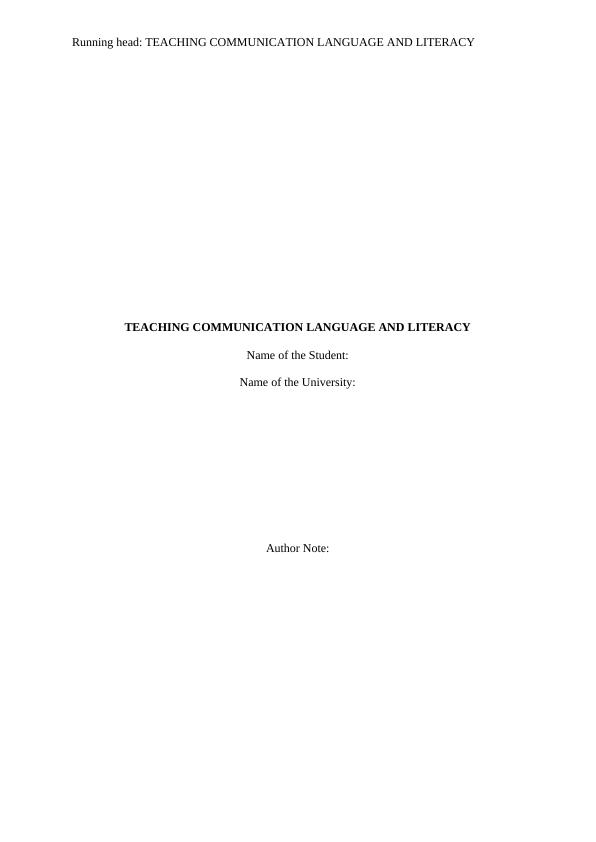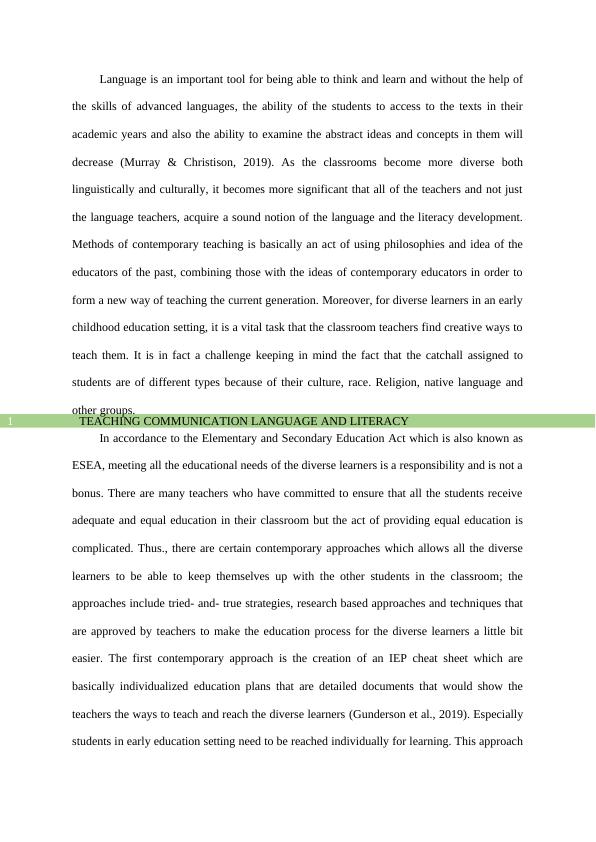Teaching Communication Language and Literacy
7 Pages2254 Words16 Views
Added on 2022-08-27
Teaching Communication Language and Literacy
Added on 2022-08-27
ShareRelated Documents
Running head: TEACHING COMMUNICATION LANGUAGE AND LITERACY
TEACHING COMMUNICATION LANGUAGE AND LITERACY
Name of the Student:
Name of the University:
Author Note:
TEACHING COMMUNICATION LANGUAGE AND LITERACY
Name of the Student:
Name of the University:
Author Note:

TEACHING COMMUNICATION LANGUAGE AND LITERACY1
Language is an important tool for being able to think and learn and without the help of
the skills of advanced languages, the ability of the students to access to the texts in their
academic years and also the ability to examine the abstract ideas and concepts in them will
decrease (Murray & Christison, 2019). As the classrooms become more diverse both
linguistically and culturally, it becomes more significant that all of the teachers and not just
the language teachers, acquire a sound notion of the language and the literacy development.
Methods of contemporary teaching is basically an act of using philosophies and idea of the
educators of the past, combining those with the ideas of contemporary educators in order to
form a new way of teaching the current generation. Moreover, for diverse learners in an early
childhood education setting, it is a vital task that the classroom teachers find creative ways to
teach them. It is in fact a challenge keeping in mind the fact that the catchall assigned to
students are of different types because of their culture, race. Religion, native language and
other groups.
In accordance to the Elementary and Secondary Education Act which is also known as
ESEA, meeting all the educational needs of the diverse learners is a responsibility and is not a
bonus. There are many teachers who have committed to ensure that all the students receive
adequate and equal education in their classroom but the act of providing equal education is
complicated. Thus., there are certain contemporary approaches which allows all the diverse
learners to be able to keep themselves up with the other students in the classroom; the
approaches include tried- and- true strategies, research based approaches and techniques that
are approved by teachers to make the education process for the diverse learners a little bit
easier. The first contemporary approach is the creation of an IEP cheat sheet which are
basically individualized education plans that are detailed documents that would show the
teachers the ways to teach and reach the diverse learners (Gunderson et al., 2019). Especially
students in early education setting need to be reached individually for learning. This approach
Language is an important tool for being able to think and learn and without the help of
the skills of advanced languages, the ability of the students to access to the texts in their
academic years and also the ability to examine the abstract ideas and concepts in them will
decrease (Murray & Christison, 2019). As the classrooms become more diverse both
linguistically and culturally, it becomes more significant that all of the teachers and not just
the language teachers, acquire a sound notion of the language and the literacy development.
Methods of contemporary teaching is basically an act of using philosophies and idea of the
educators of the past, combining those with the ideas of contemporary educators in order to
form a new way of teaching the current generation. Moreover, for diverse learners in an early
childhood education setting, it is a vital task that the classroom teachers find creative ways to
teach them. It is in fact a challenge keeping in mind the fact that the catchall assigned to
students are of different types because of their culture, race. Religion, native language and
other groups.
In accordance to the Elementary and Secondary Education Act which is also known as
ESEA, meeting all the educational needs of the diverse learners is a responsibility and is not a
bonus. There are many teachers who have committed to ensure that all the students receive
adequate and equal education in their classroom but the act of providing equal education is
complicated. Thus., there are certain contemporary approaches which allows all the diverse
learners to be able to keep themselves up with the other students in the classroom; the
approaches include tried- and- true strategies, research based approaches and techniques that
are approved by teachers to make the education process for the diverse learners a little bit
easier. The first contemporary approach is the creation of an IEP cheat sheet which are
basically individualized education plans that are detailed documents that would show the
teachers the ways to teach and reach the diverse learners (Gunderson et al., 2019). Especially
students in early education setting need to be reached individually for learning. This approach

TEACHING COMMUNICATION LANGUAGE AND LITERACY2
is for the benefit of the teachers so that they can keep reminding themselves what is needed to
teach a class full of diverse learners and what laws are needed to be abided whilst teaching
them. The next approach is to encourage the act of active learning in the classroom; there are
times when an educator plans a lesson and thinks of the way that he/she is going to teach it in
the class. But when they start teaching it does not go the way they planned. This issue
demonstrates an important contemporary lesson that teaching facts should be shared with the
students so that they start participating. It might be a challenge to keep the learners engaged
and actively involved especially for the ones who speak diverse language; in such cases the
teacher can incorporate learning methods like group learning, group discussions, case- based
learning, memory matrixes or even one- sentence summaries. Another contemporary
approach proved that grouping on the basis of ability is more productive than grouping on the
basis of learning style. However, it is also known that grouping by learning style also makes
teaching easier, but this approach does not boost the struggling students; instead it boosts the
students at intermediate levels to higher level. Hence, it would be more effective if students
are grouped in mixed ability groups so that it can promote learning; mixed ability groups
easily promote learning since the students get a chance to coach their peers (Du Plessis,
2019). Next, project -based learning is also a well- known and contemporary approach which
is suitable for teaching diverse learners. Early childhood setting students would be in fact
more interested in project- based learning than whatever that is taught to them in regular
classes. In this type of learning the kids learn to solve real world problems and come up with
a solution together if they are put in a group together. Thus, not only they are educated, the
diverse learners get a chance to connect and communicate with the other students to feel
included.
Inclusion is the practice that ensures that all the children are included and they feel
included in their early learning regardless of their differences, in this case difference in
is for the benefit of the teachers so that they can keep reminding themselves what is needed to
teach a class full of diverse learners and what laws are needed to be abided whilst teaching
them. The next approach is to encourage the act of active learning in the classroom; there are
times when an educator plans a lesson and thinks of the way that he/she is going to teach it in
the class. But when they start teaching it does not go the way they planned. This issue
demonstrates an important contemporary lesson that teaching facts should be shared with the
students so that they start participating. It might be a challenge to keep the learners engaged
and actively involved especially for the ones who speak diverse language; in such cases the
teacher can incorporate learning methods like group learning, group discussions, case- based
learning, memory matrixes or even one- sentence summaries. Another contemporary
approach proved that grouping on the basis of ability is more productive than grouping on the
basis of learning style. However, it is also known that grouping by learning style also makes
teaching easier, but this approach does not boost the struggling students; instead it boosts the
students at intermediate levels to higher level. Hence, it would be more effective if students
are grouped in mixed ability groups so that it can promote learning; mixed ability groups
easily promote learning since the students get a chance to coach their peers (Du Plessis,
2019). Next, project -based learning is also a well- known and contemporary approach which
is suitable for teaching diverse learners. Early childhood setting students would be in fact
more interested in project- based learning than whatever that is taught to them in regular
classes. In this type of learning the kids learn to solve real world problems and come up with
a solution together if they are put in a group together. Thus, not only they are educated, the
diverse learners get a chance to connect and communicate with the other students to feel
included.
Inclusion is the practice that ensures that all the children are included and they feel
included in their early learning regardless of their differences, in this case difference in

End of preview
Want to access all the pages? Upload your documents or become a member.
Related Documents
Teaching Communication, Language and Literacy to Multilingual Learners in Early Childhood Settingslg...
|10
|2745
|51
Contemporary Approaches for Teaching Communication and Literacy in Early Childhood Educationlg...
|10
|2376
|50
Differentiated Teaching Theory PowerPoint Presentation 2022lg...
|5
|536
|23
Teaching Communication and Language to Diverse Learnerslg...
|8
|2279
|31
Teaching communication language and literacy Assignmentlg...
|8
|2282
|132
Early Childhood Education and Carelg...
|9
|2606
|328
